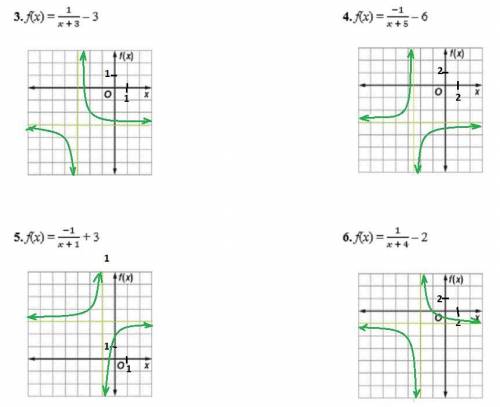1.

x-1 = 0 for x = 1
so:
Vertical asymptote: x = 1
Domain: Dom f = R\{1} {or: Dom f = (-∞, 1)∪(1, ∞)}
Horizontal asymptote: y = 0
Range: Ran f=R\{0} {or: Ran f = (-∞, 0)∪(0, ∞)}
2.

x-0 = 0 for x = 0
so:
Vertical asymptote: x = 0
Domain: Dom f = R\{0} {or: Dom f = (-∞, 0)∪(0, ∞)}
Horizontal asymptote: y = 4
Range: Ran f=R\{4} {or: Ran f = (-∞, 4)∪(4, ∞)}
3.

x+3 = 0 for x = -3
so:
Vertical asymptote: x = -3
Domain: Dom f = R\{-3} {or: Dom f = (-∞, -3)∪(-3, ∞)}
Horizontal asymptote: y = -3
Range: Ran f=R\{-3} {or: Ran f = (-∞, -3)∪(-3, ∞)}
4.

x+5 = 0 for x = -5
so:
Vertical asymptote: x = -5
Domain: Dom f = R\{-5} {or: Dom f = (-∞, -5)∪(-5, ∞)}
Horizontal asymptote: y = -6
Range: Ran f=R\{-6} {or: Ran f = (-∞, -6)∪(-6, ∞)}
4.

x+1 = 0 for x = -1
so:
Vertical asymptote: x = -1
Domain: Dom f = R\{-1} {or: Dom f = (-∞, -1)∪(-1, ∞)}
Horizontal asymptote: y = -6
Range: Ran f=R\{3} {or: Ran f = (-∞, 3)∪(3, ∞)}
5.

x+4 = 0 for x = -4
so:
Vertical asymptote: x = -4
Domain: Dom f = R\{-4} {or: Dom f = (-∞, -4)∪(-4, ∞)}
Horizontal asymptote: y = -2
Range: Ran f=R\{-2} {or: Ran f = (-∞, -2)∪(-2, ∞)}
